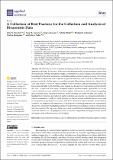Files in this item
A collection of best practices for the collection and analysis of bioacoustic data
Item metadata
| dc.contributor.author | Oswald, Julie N. | |
| dc.contributor.author | Van Cise, Amy M. | |
| dc.contributor.author | Dassow, Angela | |
| dc.contributor.author | Elliott, Taffeta | |
| dc.contributor.author | Johnson , Michael T. | |
| dc.contributor.author | Ravignani, Andrea | |
| dc.contributor.author | Podos, Jeffrey | |
| dc.date.accessioned | 2022-11-25T10:30:11Z | |
| dc.date.available | 2022-11-25T10:30:11Z | |
| dc.date.issued | 2022-11-25 | |
| dc.identifier | 282257036 | |
| dc.identifier | 463b61d9-bb6a-45db-bd46-de5fe8eaa9bd | |
| dc.identifier | 85144277012 | |
| dc.identifier | 000895123700001 | |
| dc.identifier.citation | Oswald , J N , Van Cise , A M , Dassow , A , Elliott , T , Johnson , M T , Ravignani , A & Podos , J 2022 , ' A collection of best practices for the collection and analysis of bioacoustic data ' , Applied Sciences , vol. 12 , no. 23 , 12046 . https://doi.org/10.3390/app122312046 | en |
| dc.identifier.issn | 2076-3417 | |
| dc.identifier.uri | https://hdl.handle.net/10023/26498 | |
| dc.description.abstract | The field of bioacoustics is rapidly developing and characterized by diverse methodologies, approaches and aims. For instance, bioacoustics encompasses studies on the perception of pure tones in meticulously controlled laboratory settings, documentation of species’ presence and activities using recordings from the field, and analyses of circadian calling patterns in animal choruses. Newcomers to the field are confronted with a vast and fragmented literature, and a lack of accessible reference papers or textbooks. In this paper we contribute towards filling this gap. Instead of a classical list of “dos” and “don’ts”, we review some key papers which, we believe, embody best practices in several bioacoustic subfields. In the first three case studies, we discuss how bioacoustics can help identify the ‘who’, ‘where’ and ‘how many’ of animals within a given ecosystem. Specifically, we review cases in which bioacoustic methods have been applied with success to draw inferences regarding species identification, population structure, and biodiversity. In fourth and fifth case studies, we highlight how structural properties in signal evolution can emerge via ecological constraints or cultural transmission. Finally, in a sixth example, we discuss acoustic methods that have been used to infer predator–prey dynamics in cases where direct observation was not feasible. Across all these examples, we emphasize the importance of appropriate recording parameters and experimental design. We conclude by highlighting common best practices across studies as well as caveats about our own overview. We hope our efforts spur a more general effort in standardizing best practices across the subareas we’ve highlighted in order to increase compatibility among bioacoustic studies and inspire cross-pollination across the discipline. | |
| dc.format.extent | 22 | |
| dc.format.extent | 2388852 | |
| dc.language.iso | eng | |
| dc.relation.ispartof | Applied Sciences | en |
| dc.subject | Bioacoustics | en |
| dc.subject | Best practices | en |
| dc.subject | Species identification | en |
| dc.subject | Population structure | en |
| dc.subject | Signal evolution | en |
| dc.subject | QH301 Biology | en |
| dc.subject | MCC | en |
| dc.subject.lcc | QH301 | en |
| dc.title | A collection of best practices for the collection and analysis of bioacoustic data | en |
| dc.type | Journal item | en |
| dc.contributor.institution | University of St Andrews. Sea Mammal Research Unit | en |
| dc.contributor.institution | University of St Andrews. Scottish Oceans Institute | en |
| dc.contributor.institution | University of St Andrews. School of Biology | en |
| dc.identifier.doi | https://doi.org/10.3390/app122312046 | |
| dc.description.status | Peer reviewed | en |
This item appears in the following Collection(s)
Items in the St Andrews Research Repository are protected by copyright, with all rights reserved, unless otherwise indicated.

